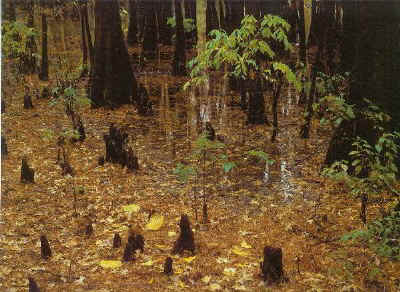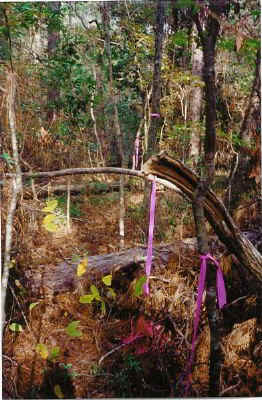|
==============================================================================
TOPIC: Big Thicket, TX
http://groups.google.com/group/entstrees/browse_thread/thread/ff623e530da65272?hl=en
==============================================================================
== 2 of 6 ==
Date: Mon, Mar 24 2008 1:03 pm
From: Don Staples
Ed, the Big Thicket is an interesting bio diverse section of the
Gulf
Coast. Depending on who you listen to, there are 7, 8, or 9 distinct
biological association represented, any where from cactus flats to
semi tropical wet lands. And, while not associated directly to the
Monument, there are areas of the original blackland little blue stem
prairie in the same area. The Monument itself is unique in a number
of ways, not the lest is the way it has been constructed. It is
primarily a river (creek) corridor that stretches across some 150
miles of east Texas. It starts in my home county, Polk, and goes
east
till hit hits the Angelina river that drops to the Gulf at Beaumont,
Texas. Along the way there are several larger tracts that have been
added on over the years to protect special areas. One of the largest
is on the south border the Alabama-Coushatta Indian reservation, and
has the look and feel of the Pioneer forest days in east Texas.
There
is a shot of a survey crew on my web page that was taken inside this
portion of the Monument.

Loblolly Pine in the Big Thicket - technician for scale
The Monument can be very difficult to see, for a casual visitor. The
larger tracts are more or less accessible, but the corridor itself
has
limited access due to private ownership around it. The best way to
see it is by canoe on the creeks. And that can be an arduous journey
unless the creeks are running full.
You are correct on the diversity of plant life, there are several
varieties of orchards and carnivorous plants found here, often too
small, or indistinct, for most visitors to notice. One is an aquatic
carnivorous floating plant, seldom see, or recognized.
Along with diverse plant life is the diverse animal life, from
upland
species to swamp dwellers. There is a residual population of black
bear and cougar, becoming more noticed as their populations rebound
and more folks move into the area. Alligators are everywhere there
is water, and food. It was the home of the last known specimen of
the
Ivory Billed Woodpecker known to exist in Texas. I had the good
fortune of being lead to the site and observing the bird. Same guide
had one in his freezer. I never asked.
As compliance officer I and my hands would follow pipe line and
seismograph crews through the Thicket as they surveyed. They were
limited to foot traffic and hand tools, nothing over 3 inch
diameter,
stem or limb, cut, no creatures killed (although it is very
difficult
to have crew members with machetes not chop a snake that happened
their way. I was retained by the Monument folks after a couple of
years of appraising damage from legal and illegal crossings. Really
tested my limits on plant identification, but, with the help of a
local botanists I managed to stay up to the challenge. The process
we
used was to crisscross the corridor from adjacent lands, or
following
the streams to keep off adjacent land owners. After the original
damage appraisal we were hired to trail along with the crews anytime
they were on the Monument.
I fell into more creeks crossing logs than I care to remember, but
saw
a lot of interesting stuff. The timber stands there are not unique,
size wise, as compared to some of the stands in the NE. Most of the
land was cut over 80 or so years ago, and then abandoned. Some of
the
wet lands were not cut, and maintained the larger cypress, but as
logging became more efficient and capable, they, too, were taken.
What we have left is what has grown over the last 80 years or so, or
some of the residual. There is a cypress tree standing on the edge
of
one of the tracts that is over 7 foot diameter and hollow as a drum,
top broken off decades ago, but still hanging on. As an aside, a
bigger cypress exists on private land to the south of the Monument,
but access is denied the general public I was impressed by a
28"
white ash I found on the banks of one of the creeks, that size and
species was hunted down and cut for decades, not big by y'alls
standards, but on the come back.
In the other article you mention the Kirby section, I think that is
where the Pitcher Plant trail if found. That type of land is upland
flats that hold water, sort of shallow swamps that dry up some of
the
year. Years ago there was this type of stand on a state forest that
I
helped maintain. Control burning was used to reduce the inroads by
brush, and follow the old tradition of "burning the woods"
that
actually was beneficial to some of the timber types found in the
area.
A few years ago we were surveying for a local timber company, just
prior to their sale, and came across a 237 year old long leaf pine.
We measured it only because it was the dominant tree in a plantation
stand, at 18 inches DBH. I cored it and had to bring it back to the
office to count the rings with a low power microscope. The tree was
growing in a natural rock pocket that had limited its root growth,
but
allowed it to survive decades of logging.
I watched old east Texas disappear over the last, nearly, half
century. There were still residual stands of long leaf, and the
swamps had not been cut over. Now that has changed. The companies
have sold out to the RIT's and FIG's, they have tried to guarantee
their investors that they could return 10% annually on their
investments, and have cut the land to the bone, then put the acreage
back on the market at an inflated price. I worked for the local A-C
reservation one time to help stop a southern pine beetle infestation
that eventually killed over 8 million board feet of timber on some
of
the finest bottom land natural pine/hardwood stands left in this
area. I have a cookie cut from one of the stem we cut that is 42
inches in diameter, and only 80 years old. I manage some lands for
my
clients that we are trying to get back to that type of stand, but
economics and new generations make that difficult. I guess I was
witness to the last of the old southern forest, now just trying to
grow it back, successfully, at times, in small tracts.
Southern forests can be regenerated to near original conditions,
some
animal and plant species cannot be renewed, but much can be. There
is
a "wilderness area" in an adjacent county that is being
fought over by
the environmentalists and the USFS. The argument is that this
"virgin
forest" needs to be left alone to its on devices. They refuse
to
believe that in 1930's the area was a stump pasture for miles, and
the
old CCC replanted it, their wilderness is a 70 or so year old
plantation!.
I think that is what brought me to this group, and the original that
you referenced below. The desire to identify and preserve some of
the
old world. Bob and I conversed some back then, but I cannot remember
what it was all about, I stayed on the peripheries most of the time.
I think Joe, and his buddy Karl Davis, were more in alignment with
NEFR.
When in the service we used to camp under 350 year old beech trees
that had a few more decades till harvest. I can only hope that there
are some here in the USA that can make some of this world look like
those old stands. But not in this life time.
On Mar 24, 1:00 pm, "Edward Frank" <edfr...@comcast.net>
wrote:
> Don,
>
> I see in your Bio sketch you were a compliance oficer for the
Big Thickey National Preserve. I have visited there once a couple
yearws agohttp://www.nativetreesociety.org/fieldtrips/us_west/texas/bigthicket/
.... Could you tell us something more about it as you must have
spent more time than any of us? it is sort of a biological
cross-roads from what have read.
>
> Ed Frank
>
> I am also curious about the Northeast Forest Reformation group
that Bob often alludes to, but doesn't really discuss. What was it
about, and why did it break up?
== 3 of 6 ==
Date: Mon, Mar 24 2008 1:56 pm
From: DON BERTOLETTE
DonS-
An excellent 'second look' at the Big Thicket. A good friend of mine
worked there some years back and enjoyed his tenure there.
Thanks for the report.
-DonB
== 5 of 6 ==
Date: Mon, Mar 24 2008 4:16 pm
From: dbhguru@comcast.net
Don,
Excellent post. Very interesting. Thanks.
Bob
==============================================================================
TOPIC: Big Thicket, TX
http://groups.google.com/group/entstrees/browse_thread/thread/ff623e530da65272?hl=en
==============================================================================
== 1 of 2 ==
Date: Sat, Mar 29 2008 7:14 am
From: Don
Not sure if this is going to work, but, uploaded two photos from the
Thicket to see if I could make it work.

This particular shot is a part of the world that is tough to work
in,
hidden traps under water. I was following a crew in the Thicket
through a section that was not near as wet as the photo, stepped
into
what looked like a run off, to find it waist deep and only some
18"
wide.
I think I am getting a little old for some of this sort of field
work.
== 2 of 2 ==
Date: Sat, Mar 29 2008 7:19 am
From: Don
And here is one of the reasons they call it "The Thicket"

Soil moisture and growing season on the Gulf Coast makes for a near
tropical growth rate of understory plants. This area was in a blow
down, a year or so after the trees went down.
|